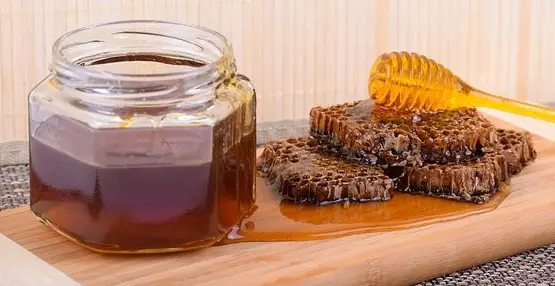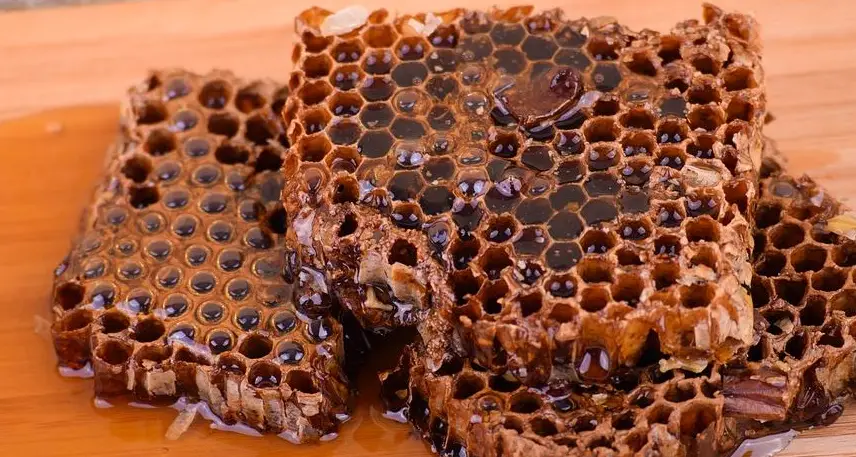Honey – a sweet viscous substance produced by bees. Bees produce honey from flower nectar (sugar-rich plant secretions) and store it in a waxy structure called honeycomb. The honey variety produced by honey bees is best known for its global commercial production and use. Honey can be harvested either from wild bee colonies or from the hives of domestic bees, an activity known as beekeeping.
The sweet taste of honey comes from the monosaccharides fructose and glucose, and its sweetness is approximately the same as that of sucrose. Due to this feature, it is often used for culinary purposes as a sweetener. One of the interesting features of honey is that most microorganisms are not able to grow in it, so honey does not spoil, even for thousands of years. One tablespoon of honey (15 milliliters) supplies the body with 64 calories, which is equivalent to 1272 kJ per 100 g of energy intake.
Human consumption of honey has a long history, dating back thousands of years; as evidenced by cave paintings dating back 8,000 years, discovered near the city of Valencia, Spain, depicting human figures collecting honey.
What is raw honey?
Raw honey comes directly from the honeycomb. The beekeeper usually simply filters the honey to remove small pieces of waste such as pollen, beeswax, parts of dead bees. Raw honey is not pasteurized and looks cloudy.
What is the difference between raw and processed honey?
Raw honey is the more natural version between the two types of honey and offers more health benefits. Honey is a food known for its nutritional benefits as well as its healing properties. Honey is tea’s best friend and is especially revered among people who eat healthily. In general, raw honey comes directly from the hive, while the treated honey goes through different processes while bottling. The main difference between the two types of copper is the amount of processing. The raw copper is filtered and bottled with minimal treatment. The processed honey is processed and pasteurized at high temperature, which can significantly reduce the amount of enzymes and antioxidants in it. For this reason, raw honey is a healthier choice.

Credits to: healthyandnaturalworld.com
In either case, both types of honey are healthy and regular consumption is recommended. Here are some health benefits of consuming honey.
Honey lowers cholesterol
Bad cholesterol, known as LDL cholesterol, is one of the biggest risk factors for developing heart disease. This type of cholesterol plays a huge role in clogging the arteries, which in turn leads to heart attacks and strokes. Several studies show that honey can lower bad cholesterol levels. It lowers bad cholesterol and increases good cholesterol.
It lowers blood pressure
Blood pressure is an important risk factor for heart disease, and honey can help reduce it. This is because it contains antioxidants, which are associated with lowering blood pressure. Studies show that people who consumed honey had lower blood pressure than those who did not.
Prevent allergies
Honey contains bee pollen, which is known to remove infections, provide a natural anti-allergic effect and stimulate overall immunity. The ability of honey to prevent allergies is based on a concept called immunotherapy. How does it work? Bees in your neighborhood go from flower to flower, collecting pollen that causes allergies, but when you consume local unprocessed honey, you also consume the same local pollen. After a while, an allergy sufferer may become less sensitive to this pollen, which has previously caused problems.
Helps reduce cough
Cough is a common problem in children with upper respiratory infections. These infections can affect the quality of sleep in both children and parents. Medications and syrups may not always help in such cases, so it may be a better choice to consume honey.
Helps detoxify the body
Our body is affected daily by harmful toxins that we ingest through food and drink. Therefore, detoxification is required. Honey contains flavonoids that help alleviate the imbalance of radicals, toxins and antioxidants in the body, leading to tissue damage.

